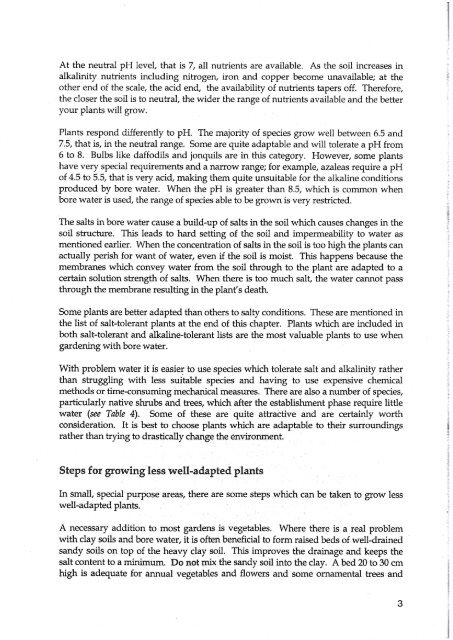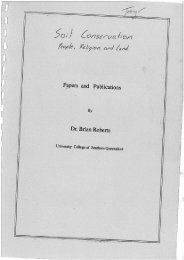western-queensland-gardening-guide.pdf - South West NRM
western-queensland-gardening-guide.pdf - South West NRM
western-queensland-gardening-guide.pdf - South West NRM
You also want an ePaper? Increase the reach of your titles
YUMPU automatically turns print PDFs into web optimized ePapers that Google loves.
At the neutral pH level, that is 7, all nutrients are available. As the soil increases in<br />
alkalinity nutrients including nitrogen, iron and copper become unavailable; at the<br />
other end of the scale, the acid end, the availability of nutrients tapers off. Therefore,<br />
the closer the soil is to neutral, the wider the range of nutrients available and the better<br />
your plants will grow.<br />
Plants respond differently to pH. The majority of species grow well between 6.5 and<br />
7.5, that is, in the neutral range. Some are quite adaptable and will tolerate a pH from<br />
6 to 8. Bulbs like daffodils and jonquils are in this category. However, some plants<br />
have very special requirements and a narrow range; for example, azaleas require a pH<br />
of 4.5 to 5.5, that is very acid, making them quite unsuitable for the alkaline conditions<br />
produced by bore water. When the pH is greater than 8.5, which is common when<br />
bore water is used, the range of species able to be grown is very restricted.<br />
The salts in bore water cause a build-up of salts in the soil which causes changes in the<br />
soil structure. This leads to hard setting of the soil and impermeability to water as<br />
mentioned earlier. When the concentration of salts in the soil is too high the plants can<br />
actually perish for want of water, even if the soil is moist. This happens because the<br />
membranes which convey water from the soil through to the plant are adapted to a<br />
certain solution strength of salts. n there is too much salt, the water cannot pass<br />
through the membrane resulting in the plant's death.<br />
Some plants are better adapted than others to salty conditions. These are mentioned in<br />
the list of salt-tolerant plants at the end of this chapter. Plants which are included in<br />
both salt-tolerant and alkaline-tolerant lists are the most valuable plants to use when<br />
<strong>gardening</strong> with bore water.<br />
With problem water it is easier to use species which tolerate salt and alkalinity rather<br />
than struggling with less suitable species and having to use expensive chemical<br />
methods or time-consuming mechanical measures. There are also a number of species,<br />
particularly native shrubs and trees, which after the establishment phase require little<br />
water (see Table 4). Some of these are quite attractive and are certainly worth<br />
consideration. It is best to choose plants which are adaptable to their surroundings<br />
rather than trying to drastically change the environment.<br />
Steps for growing less well-adapted plants<br />
In small, special purpose areas, there are some steps which can be taken to grow less<br />
well-adapted plants.<br />
A necessary addition to most gardens is vegetables. Where there is a real problem<br />
with clay soils and bore water, it is often beneficial to form raised beds of well-drained<br />
sandy soils on top of the heavy clay soil. This improves the drainage and keeps the<br />
salt content to a minimum. Do not mix the sandy soil into the clay. A bed 20 to 30 cm<br />
high is adequate for annual vegetables and flowers and some ornamental trees and
















